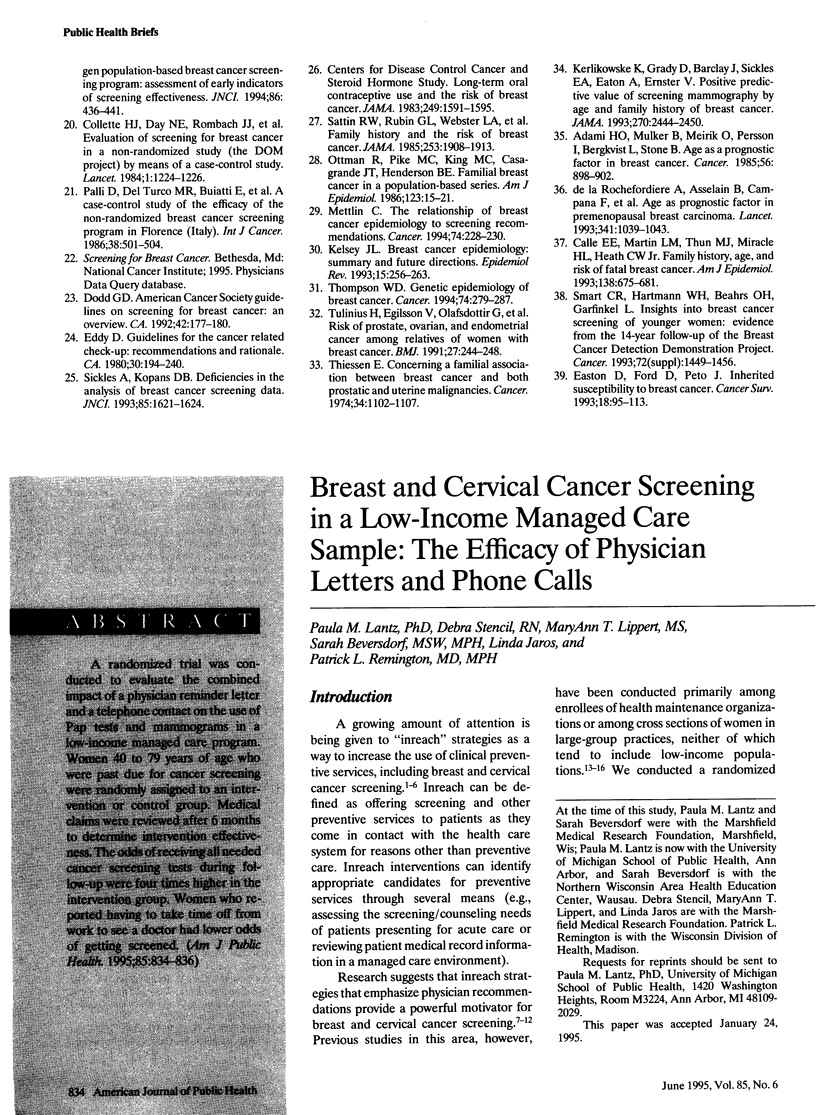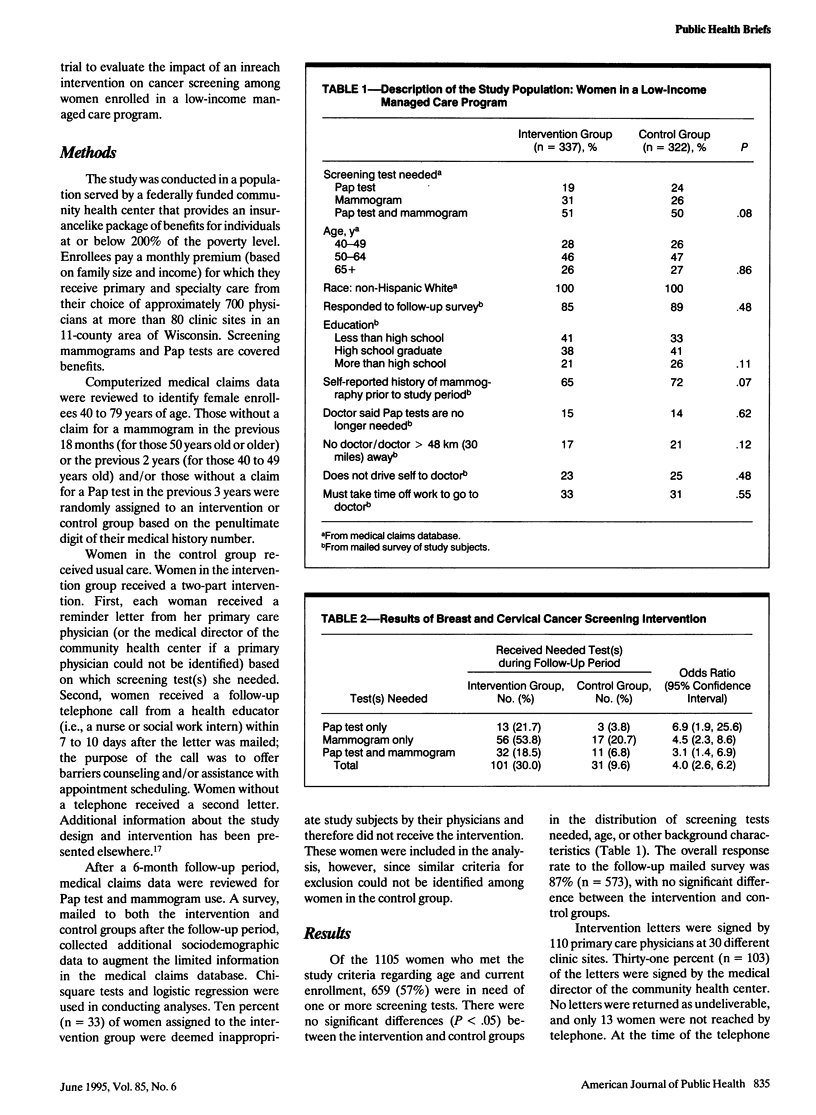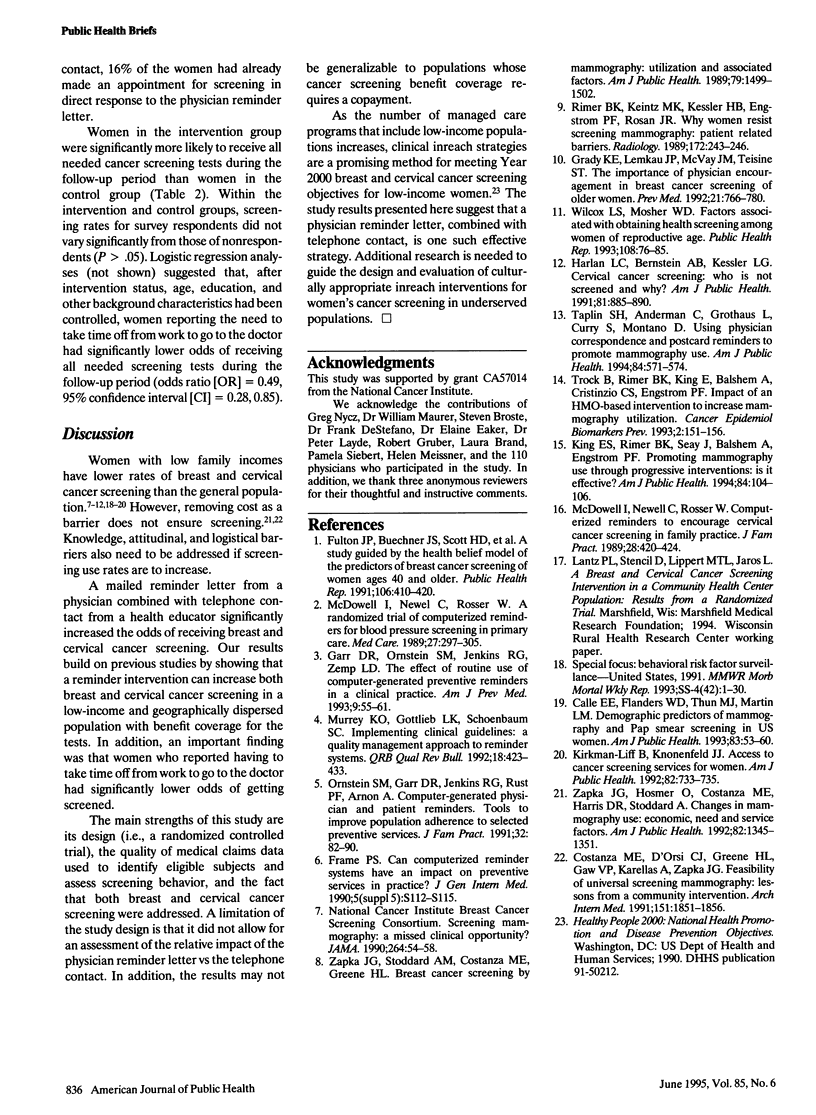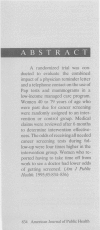Abstract
A randomized trial was conducted to evaluate the combined impact of a physician reminder letter and a telephone contact on the use of Pap tests and mammograms in a low-income managed care program. Women 40 to 79 years of age who were past due for cancer screening were randomly assigned to an intervention or control group. Medical claims were reviewed after 6 months to determine intervention effectiveness. The odds of receiving all needed cancer screening tests during follow-up were four times higher in the intervention group. Women who reported having to take time off from work to see a doctor had lower odds of getting screened.
Full text
PDF


Images in this article
Selected References
These references are in PubMed. This may not be the complete list of references from this article.
- Calle E. E., Flanders W. D., Thun M. J., Martin L. M. Demographic predictors of mammography and Pap smear screening in US women. Am J Public Health. 1993 Jan;83(1):53–60. doi: 10.2105/ajph.83.1.53. [DOI] [PMC free article] [PubMed] [Google Scholar]
- Costanza M. E., D'Orsi C. J., Greene H. L., Gaw V. P., Karellas A., Zapka J. G. Feasibility of universal screening mammography. Lessons from a community intervention. Arch Intern Med. 1991 Sep;151(9):1851–1856. [PubMed] [Google Scholar]
- Frame P. S. Can computerized reminder systems have an impact on preventive services in practice? J Gen Intern Med. 1990 Sep-Oct;5(5 Suppl):S112–S115. doi: 10.1007/BF02600855. [DOI] [PubMed] [Google Scholar]
- Fulton J. P., Buechner J. S., Scott H. D., DeBuono B. A., Feldman J. P., Smith R. A., Kovenock D. A study guided by the Health Belief Model of the predictors of breast cancer screening of women ages 40 and older. Public Health Rep. 1991 Jul-Aug;106(4):410–420. [PMC free article] [PubMed] [Google Scholar]
- Garr D. R., Ornstein S. M., Jenkins R. G., Zemp L. D. The effect of routine use of computer-generated preventive reminders in a clinical practice. Am J Prev Med. 1993 Jan-Feb;9(1):55–61. [PubMed] [Google Scholar]
- Grady K. E., Lemkau J. P., McVay J. M., Reisine S. T. The importance of physician encouragement in breast cancer screening of older women. Prev Med. 1992 Nov;21(6):766–780. doi: 10.1016/0091-7435(92)90083-t. [DOI] [PubMed] [Google Scholar]
- Harlan L. C., Bernstein A. B., Kessler L. G. Cervical cancer screening: who is not screened and why? Am J Public Health. 1991 Jul;81(7):885–890. doi: 10.2105/ajph.81.7.885. [DOI] [PMC free article] [PubMed] [Google Scholar]
- King E. S., Rimer B. K., Seay J., Balshem A., Engstrom P. F. Promoting mammography use through progressive interventions: is it effective? Am J Public Health. 1994 Jan;84(1):104–106. doi: 10.2105/ajph.84.1.104. [DOI] [PMC free article] [PubMed] [Google Scholar]
- Kirkman-Liff B., Kronenfeld J. J. Access to cancer screening services for women. Am J Public Health. 1992 May;82(5):733–735. doi: 10.2105/ajph.82.5.733. [DOI] [PMC free article] [PubMed] [Google Scholar]
- McDowell I., Newell C., Rosser W. A randomized trial of computerized reminders for blood pressure screening in primary care. Med Care. 1989 Mar;27(3):297–305. doi: 10.1097/00005650-198903000-00008. [DOI] [PubMed] [Google Scholar]
- McDowell I., Newell C., Rosser W. Computerized reminders to encourage cervical screening in family practice. J Fam Pract. 1989 Apr;28(4):420–424. [PubMed] [Google Scholar]
- Murrey K. O., Gottlieb L. K., Schoenbaum S. C. Implementing clinical guidelines: a quality management approach to reminder systems. QRB Qual Rev Bull. 1992 Dec;18(12):423–433. doi: 10.1016/s0097-5990(16)30568-1. [DOI] [PubMed] [Google Scholar]
- Ornstein S. M., Garr D. R., Jenkins R. G., Rust P. F., Arnon A. Computer-generated physician and patient reminders. Tools to improve population adherence to selected preventive services. J Fam Pract. 1991 Jan;32(1):82–90. [PubMed] [Google Scholar]
- Rimer B. K., Keintz M. K., Kessler H. B., Engstrom P. F., Rosan J. R. Why women resist screening mammography: patient-related barriers. Radiology. 1989 Jul;172(1):243–246. doi: 10.1148/radiology.172.1.2740510. [DOI] [PubMed] [Google Scholar]
- Taplin S. H., Anderman C., Grothaus L., Curry S., Montano D. Using physician correspondence and postcard reminders to promote mammography use. Am J Public Health. 1994 Apr;84(4):571–574. doi: 10.2105/ajph.84.4.571. [DOI] [PMC free article] [PubMed] [Google Scholar]
- Trock B., Rimer B. K., King E., Balshem A., Cristinzio C. S., Engstrom P. F. Impact of an HMO-based intervention to increase mammography utilization. Cancer Epidemiol Biomarkers Prev. 1993 Mar-Apr;2(2):151–156. [PubMed] [Google Scholar]
- Wilcox L. S., Mosher W. D. Factors associated with obtaining health screening among women of reproductive age. Public Health Rep. 1993 Jan-Feb;108(1):76–86. [PMC free article] [PubMed] [Google Scholar]
- Zapka J. G., Hosmer D., Costanza M. E., Harris D. R., Stoddard A. Changes in mammography use: economic, need, and service factors. Am J Public Health. 1992 Oct;82(10):1345–1351. doi: 10.2105/ajph.82.10.1345. [DOI] [PMC free article] [PubMed] [Google Scholar]
- Zapka J. G., Stoddard A. M., Costanza M. E., Greene H. L. Breast cancer screening by mammography: utilization and associated factors. Am J Public Health. 1989 Nov;79(11):1499–1502. doi: 10.2105/ajph.79.11.1499. [DOI] [PMC free article] [PubMed] [Google Scholar]



